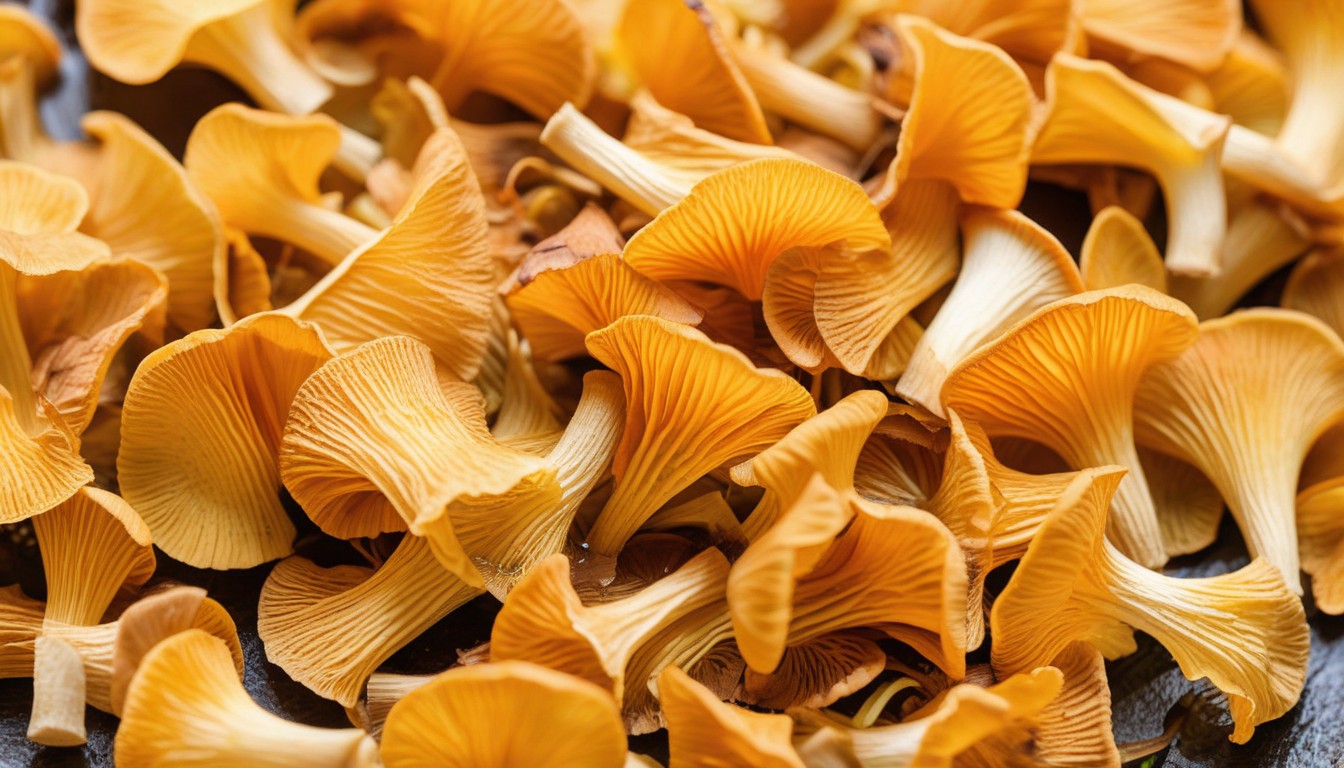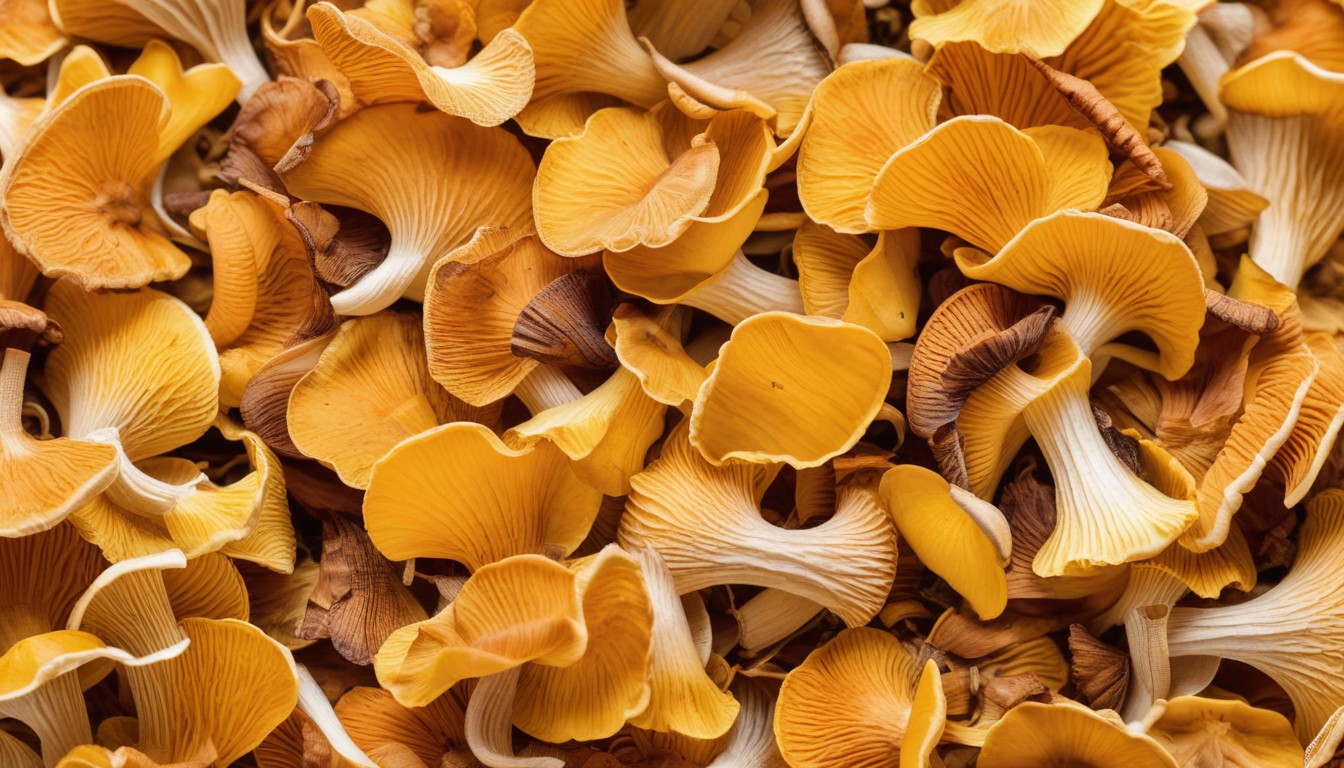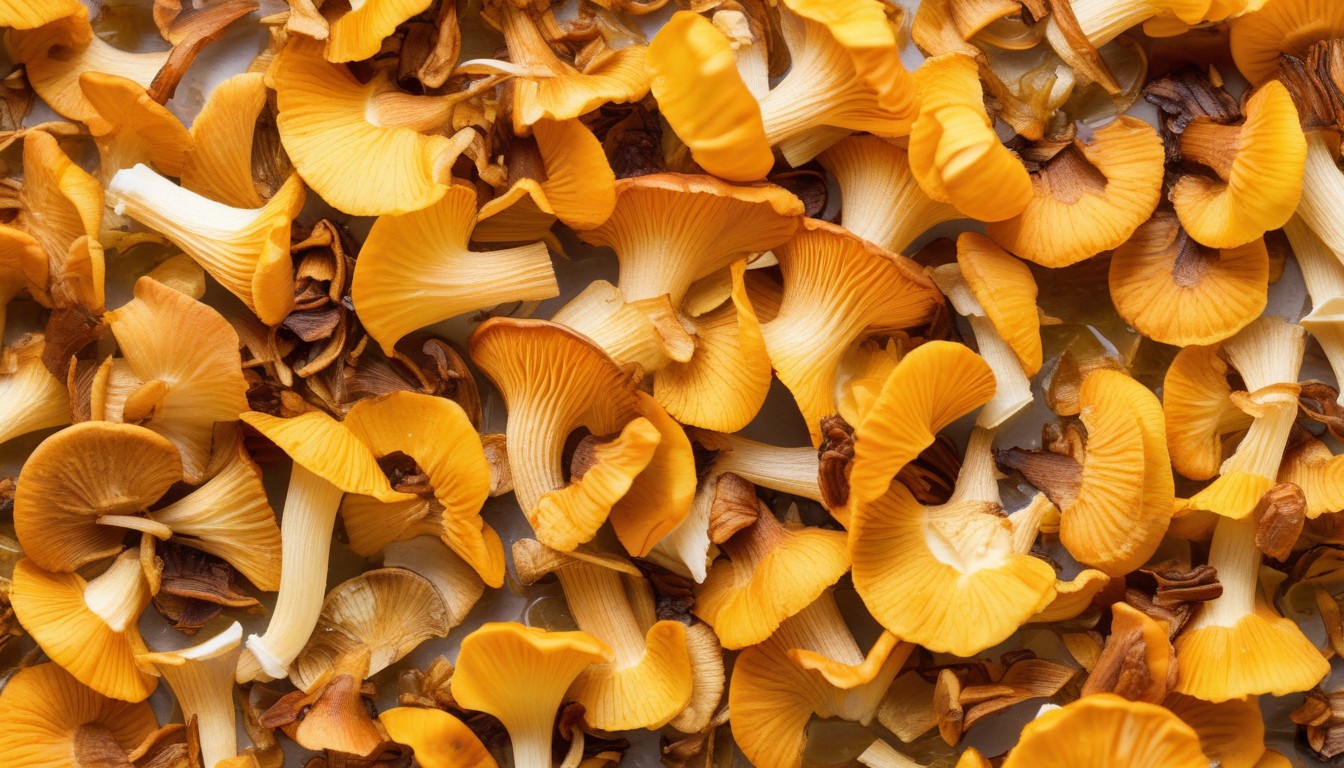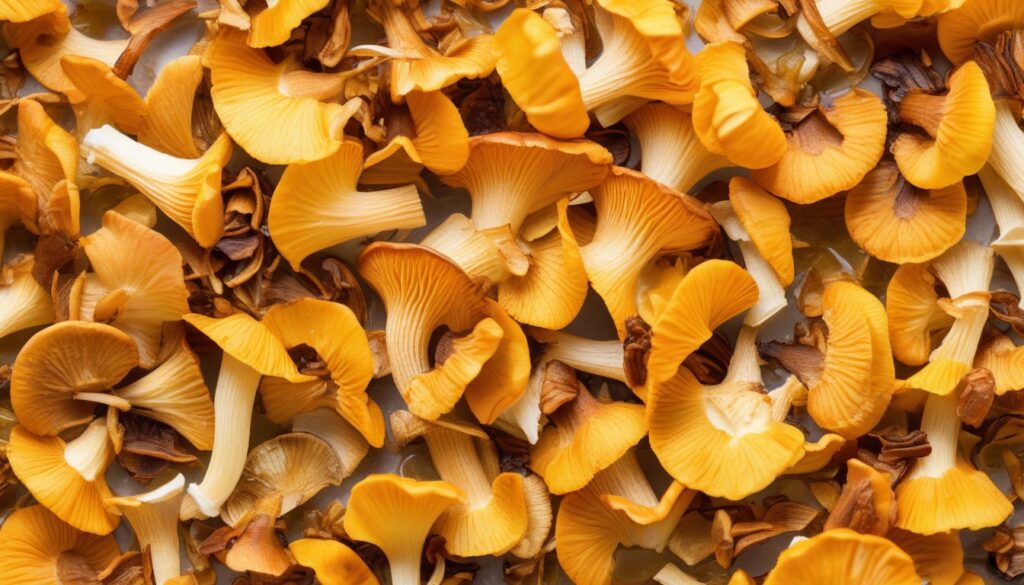Welcome to our comprehensive guide on dehydrated chanterelle mushrooms! As a culinary enthusiast, you probably know that chanterelle mushrooms are a real treat for the taste buds. But have you ever tried dehydrated chanterelle mushrooms? These gourmet mushrooms offer rich, earthy flavors that can elevate your cooking to new heights and provide convenience and versatility in the kitchen.
In this premium guide, we’ll explore the world of dehydrated chanterelle mushrooms, from their benefits to culinary uses, rehydration techniques, storing practices, and where to buy them. You’ll also find expert cooking tips and mouth-watering recipes to inspire your culinary imagination.
Key Takeaways:
- Discover the rich, earthy flavors of dehydrated chanterelle mushrooms
- Learn about their extended shelf life and versatility in the kitchen
- Find out how to rehydrate them properly to preserve their unique texture and flavor
- Explore creative ways to use these mushrooms in a range of sweet and savory dishes
- Understand the differences between fresh and dehydrated chanterelle mushrooms to make informed decisions
What Are Dehydrated Chanterelle Mushrooms?
Dehydrated chanterelle mushrooms are a type of mushroom that has undergone a drying process to preserve their unique flavor and nutritional properties. Fresh chanterelle mushrooms can be difficult to find and have a short shelf life, making the dehydrated variety a popular choice for chefs and home cooks alike.
The process of dehydrating chanterelle mushrooms involves removing the moisture from them, concentrating their flavor and extending their shelf life. The mushrooms are typically sliced and then placed in a dehydrator or oven at a low temperature for several hours until they are completely dry.
One of the advantages of dehydrated chanterelle mushrooms is that they retain much of their natural flavor and nutrients, making them an excellent ingredient for enhancing the taste of your dishes. They also pack a stronger flavor than fresh mushrooms, which can add depth and complexity to various recipes.
If you’re a fan of mushrooms and love experimenting with different flavors and textures, dehydrated chanterelle mushrooms are a must-try ingredient that you won’t want to miss out on!
The Benefits of Dehydrated Chanterelle Mushrooms
Dehydrated chanterelle mushrooms are a key ingredient for any home cook looking to introduce a new level of culinary expertise to their recipes. These mushrooms are not only delicious, but they also provide several benefits that make them worth having in your pantry:
- Extended shelf life: Unlike fresh mushrooms, dehydrated chanterelles have a much longer shelf life, allowing you to keep them on hand for whenever the culinary inspiration hits.
- Concentrated flavor: Dehydrated chanterelle mushrooms have an incredibly rich and concentrated flavor, allowing you to add depth and complexity to a range of dishes.
- Versatility: These mushrooms have a range of culinary uses, making them a valuable ingredient to have on hand in the kitchen for soups, sauces, risottos, and other dishes.
- Nutritional value: Dehydrated chanterelle mushrooms are packed with nutritional value, containing high levels of antioxidants, fiber, and essential vitamins and minerals.
- Cooking convenience: Unlike fresh mushrooms that require washing and cutting, dehydrated mushrooms can be easily rehydrated with water or broth, making them a quick and convenient addition to your recipes.
As you can see, there are many reasons why dehydrated chanterelle mushrooms are a valuable addition to any pantry. Not only do they offer delicious flavor, but they provide a range of benefits that make them a must-have ingredient for any budding home cook or seasoned chef.
How to Use Dehydrated Chanterelle Mushrooms
If you’re new to cooking with dehydrated chanterelle mushrooms, you may be wondering where to start. Fortunately, these versatile mushrooms can be used in plenty of recipes and cooking techniques. Here are some practical tips and guidance to help you bring out the exquisite flavor and aroma of dehydrated chanterelle mushrooms:
Rehydration Techniques
The first step in using dehydrated chanterelle mushrooms is to rehydrate them. To do this, place the desired amount of mushrooms in a bowl and cover them with hot water. Allow them to soak for 10-15 minutes, or until they have absorbed enough water and become plump and tender. Drain the excess water and gently pat them dry with a paper towel before using them in your recipe.
Cooking Techniques
Dehydrated chanterelle mushrooms can be used in various recipes, such as soups, sauces, risottos, and more. Their bold, earthy flavor makes them an excellent ingredient for enhancing the taste of vegetarian dishes, pasta dishes, and meat dishes. Here are some creative ways to use these mushrooms:
- Add them to meat stews or casseroles to impart a rich, savory flavor.
- Incorporate them into sauces for pasta, fish, or chicken for a unique twist.
- Add them to rice dishes or risottos to enhance the depth of flavor.
- Sauté them with garlic and olive oil and serve them as a side dish or appetizer.
- Bake them into quiches or savory tarts for an elegant and delicious treat.
Culinary Tips
When cooking with dehydrated chanterelle mushrooms, there are a few essential tips to keep in mind:
- Use a small amount of mushrooms to start with, as they will expand significantly when rehydrated.
- Always wash them before rehydrating to remove any dust or dirt that may have accumulated during the drying process.
- Be careful not to overcook them, as this can cause them to lose their delicate flavor and texture.
- Experiment with different combinations of herbs and spices to complement their unique flavor.
By following these tips and techniques, you’ll be able to use dehydrated chanterelle mushrooms in a range of recipes, adding a memorable touch of exquisite taste to your dishes.
Rehydrating Dehydrated Chanterelle Mushrooms

Rehydrating dehydrated chanterelle mushrooms is a simple process that will restore their unique texture and flavor. To begin, measure one cup of dried mushrooms and add them to a bowl. Next, boil four cups of water and pour the hot water over the mushrooms. Let them soak for 15-20 minutes until they become plump and tender.
Once the mushrooms have rehydrated, gently rinse them with cool water to remove any excess debris. Squeeze them gently to remove any excess water, and they are ready to be used in your favorite recipes.
It is essential to remember the correct water-to-mushroom ratio when rehydrating chanterelle mushrooms. A general rule of thumb is to use four times the amount of water to the amount of mushrooms. This ratio will ensure that the mushrooms absorb enough water to restore their texture and flavor.
When preparing recipes that require dehydrated chanterelle mushrooms, you can add them directly to the recipe once they are rehydrated. Alternatively, you can strain the mushrooms and reserve the flavorful liquid to use as a broth or stock in other dishes.
Tips for Best Results:
- Use a glass or ceramic bowl to soak the mushrooms, avoiding metal containers that may affect the flavor.
- If the mushrooms are exceptionally dirty, you may want to give them a quick rinse before soaking in hot water.
- Be careful not to over-soak the mushrooms, as they can become mushy and lose their unique texture.
By following these simple steps, you can rehydrate dehydrated chanterelle mushrooms and enjoy their rich, earthy flavors in your favorite dishes.
Culinary Uses of Dehydrated Chanterelle Mushrooms
Dehydrated chanterelle mushrooms are a versatile ingredient with a unique flavor that can enhance any dish. Here are some culinary uses for dehydrated chanterelle mushrooms:
|
Use |
Description |
|---|---|
|
Flavor enhancer |
Add a small amount of rehydrated dehydrated chanterelle mushrooms to sauces, soups, or stews to enhance their flavor profile. |
|
Base ingredient |
Use dehydrated chanterelle mushrooms as a base ingredient in risottos, pasta dishes, or grain bowls for a meaty, earthy flavor. |
|
Vegetarian meat substitute |
Rehydrate and finely chop dehydrated chanterelle mushrooms, then use them as a substitute for meat in burgers, meatballs, or tacos. |
|
Baking |
Add finely ground dehydrated chanterelle mushrooms to bread, pizza crust, or quiche for a unique umami flavor. |
|
Marinades and rubs |
Create marinades or rubs for meats, poultry, or fish using rehydrated dehydrated chanterelle mushrooms for a rich, earthy flavor. |
When using dehydrated chanterelle mushrooms in your dishes, it’s essential to balance their intense flavor profile with other ingredients. Rehydrate them before use, and adjust the quantity according to your taste preferences. With these tips and techniques, you can take advantage of the exquisite taste and versatile application of dehydrated chanterelle mushrooms in your cooking.
Storing Dehydrated Chanterelle Mushrooms

Proper storage of dehydrated chanterelle mushrooms is crucial to maintain their quality, texture, and flavor over time. Here are some best practices for storing dehydrated chanterelle mushrooms:
|
Storage Method |
Ideal Conditions |
Shelf Life |
|---|---|---|
|
Air-tight Containers |
Cool and Dry Place |
Up to 1 Year |
|
Vacuum Sealed Bags |
Freezer or Fridge |
Up to 2 Years |
When storing dehydrated chanterelle mushrooms, it’s essential to protect them from moisture, heat, and light. Exposure to these factors can cause them to spoil, lose their aroma, and become less flavorful.
Air-tight glass or plastic containers are ideal for storing dehydrated chanterelle mushrooms in a cool and dry place. Make sure the containers are clean, and there’s no moisture or residue inside, which can affect their quality.
For long-term storage, vacuum-sealed bags are the best option. Seal the bags properly and store them in the freezer or fridge, depending on the expected shelf life. Frozen dehydrated chanterelle mushrooms can last up to two years if sealed correctly.
Follow these storage guidelines to ensure your dehydrated chanterelle mushrooms remain fresh, flavorful, and ready to use whenever you need them.
Where to Buy Dehydrated Chanterelle Mushrooms
If you’re looking to buy high-quality dehydrated chanterelle mushrooms, there are various options available both online and offline. To ensure you get premium products, it’s essential to find reputable suppliers. Below are some of the best places to purchase dehydrated chanterelle mushrooms:
Specialty Food Stores
Many specialty food stores offer a wide selection of dehydrated mushrooms, including chanterelles. You can check out local stores in your area or search for stores online.
Online Retailers
Online retailers are a convenient option for buying dehydrated chanterelle mushrooms, especially if you live in an area with limited availability. Some of the best online retailers include Amazon, Walmart, and specialty food online stores that focus on dried mushrooms.
Farmer’s Markets
Local farmer’s markets are a great place to buy dehydrated chanterelle mushrooms. You can talk directly to the vendors and learn about their sourcing and drying process.
When purchasing dehydrated chanterelle mushrooms, it’s important to consider availability and pricing. Prices can vary significantly based on the quality and the supplier’s location.
Cooking Tips and Recipes with Dehydrated Chanterelle Mushrooms

Dehydrated chanterelle mushrooms are a versatile ingredient that can enhance the flavor of any dish. If you’re new to cooking with these gourmet mushrooms, here are a few tips to get you started:
- Use a food processor to powderize, or finely chop the mushrooms, to create a flavorful seasoning for soups, stews, and sauces.
- Soak the mushrooms first, before adding them to your recipe. This allows them to rehydrate and retain their texture and fresh taste.
- Add the soaking liquid to your recipe. The flavorful water that you soak the chanterelle mushrooms in can be added to your recipe and used as a broth-like base for soups and stews.
- Store the mushrooms in an airtight container. To preserve their quality, store them in a cool, dry place away from direct sunlight.
Dehydrated Chanterelle Mushroom Risotto Recipe
Try this delicious risotto recipe featuring dehydrated chanterelle mushrooms for a savory, earthy twist on a classic Italian dish.
|
Ingredients: |
Instructions: |
|---|---|
|
|
Try out these recipes and tips to elevate your cooking with dehydrated chanterelle mushrooms. You’ll be delighted with the rich, earthy flavors they bring to your dishes.
The Difference Between Fresh and Dehydrated Chanterelle Mushrooms

Both fresh and dehydrated chanterelle mushrooms have unique qualities that make them suitable for different culinary applications. Understanding the differences between them can help you determine which form to use based on your cooking preferences and needs.
Flavor
One of the significant differences between fresh and dehydrated chanterelle mushrooms is their flavor. While both forms have an earthy, nutty taste, dehydrated chanterelles have a more concentrated flavor due to the drying process. Their taste also becomes more complex, with hints of smokiness and umami.
Texture
The texture is another distinguishing factor between fresh and dehydrated chanterelle mushrooms. Fresh chanterelles have a soft and delicate texture, with a slightly chewy stem. On the other hand, dehydrated chanterelles have a more robust and meaty texture, making them perfect for dishes that require a hearty ingredient.
Rehydration
Rehydrating dehydrated chanterelle mushrooms is a crucial step to bringing them back to life before using them in your cooking. While this process may seem tricky, it’s relatively simple. However, it requires the correct ratio of water to mushrooms and the proper soaking time to preserve their texture and flavor.
Culinary Applications
Fresh chanterelle mushrooms are ideal for dishes that require their delicate texture and mild flavor, such as sautéed mushrooms or salads. In contrast, dehydrated chanterelles are suitable for recipes that require a more robust flavor and meaty texture, such as soups, stews, and sauces. They also work well in dishes that need a smoky or umami flavor.
Shelf Life
One of the significant advantages of dehydrated chanterelle mushrooms is their long shelf life. Properly stored, they can last for up to two years without losing their flavor or nutrients, making them a cost-effective ingredient to have on hand.
Comparing Fresh and Dehydrated Chanterelle Mushrooms
|
Aspect |
Fresh Chanterelle Mushrooms |
Dehydrated Chanterelle Mushrooms |
|---|---|---|
|
Flavor |
Mild, delicate, nutty |
Concentrated, complex, smoky, umami |
|
Texture |
Soft, delicate, slightly chewy stem |
Robust, meaty |
|
Rehydration |
N/A |
Requires correct ratio of water to mushrooms and soaking time |
|
Culinary Applications |
Salads, sautéed mushrooms, mild dishes |
Soups, stews, sauces, dishes requiring robust flavor and meaty texture |
|
Shelf Life |
Short shelf life, perishable |
Long shelf life, can last up to two years |
Both fresh and dehydrated chanterelle mushrooms have their unique qualities depending on how they are used in the kitchen. By understanding their distinctions in terms of flavor, texture, and culinary applications, you can make informed decisions when selecting the best form of chanterelles for your next recipe.
Frequently Asked Questions about Dehydrated Chanterelle Mushrooms
Before incorporating dehydrated chanterelle mushrooms into your culinary creations, you might have some questions about their nutritional value, potential allergens, and more. Here are some frequently asked questions about dehydrated chanterelle mushrooms:
What are the nutritional benefits of dehydrated chanterelle mushrooms?
Dehydrated chanterelle mushrooms have several nutritional benefits, including being low in calories, high in fiber, and rich in vitamins and minerals such as potassium and vitamin D.
Are dehydrated chanterelle mushrooms safe for people with allergies?
While allergies to mushrooms are not common, some individuals may have a sensitivity to specific varieties. It is always best to consult with a medical professional if you have any concerns about potential food allergies or sensitivities.
How can I identify high-quality dehydrated chanterelle mushrooms?
When purchasing dehydrated chanterelle mushrooms, look for those with a uniform, golden color and a strong, earthy aroma. Mushrooms that are soft to the touch or have a musty or unpleasant odor should be avoided. Additionally, purchasing from reputable suppliers can ensure the quality and authenticity of the product.
What is the best way to store dehydrated chanterelle mushrooms?
Dehydrated chanterelle mushrooms should be stored in an airtight container in a cool, dry place away from direct sunlight. A pantry or cupboard is an ideal location for storage. Properly stored, dehydrated chanterelles can last for up to a year.
Can dehydrated chanterelle mushrooms be used as a substitute for fresh mushrooms?
Yes, dehydrated chanterelle mushrooms can be used as a substitute for fresh mushrooms in many recipes. However, it is important to note that the flavor and texture of dehydrated mushrooms may differ from fresh mushrooms. When using dehydrated chanterelles, rehydration is necessary to restore their shape, texture, and optimal flavor.
Conclusion
In conclusion, we explored the world of dehydrated chanterelle mushrooms, from their unique flavor and culinary benefits to their storage and shopping considerations. With these versatile mushrooms in your pantry, you can elevate your cooking and impress your guests with rich, earthy flavors and gourmet creations.
Whether you’re experimenting with new recipes or adding a twist to your favorite dishes, dehydrated chanterelle mushrooms offer a premium ingredient that is easy to use and enhances the taste and aroma of your food.
Thank you for reading this comprehensive guide to dehydrated chanterelle mushrooms. We hope it has inspired you to explore new culinary horizons and incorporate these exquisite mushrooms into your cooking repertoire.
FAQ
What are dehydrated chanterelle mushrooms?
Dehydrated chanterelle mushrooms are fresh chanterelle mushrooms that have been dried, allowing them to retain their unique flavor and nutritional benefits in a condensed form.
What are the benefits of using dehydrated chanterelle mushrooms?
There are numerous benefits to using dehydrated chanterelle mushrooms. They have a longer shelf life, intensified flavor profile, and can enhance the taste of various dishes while providing culinary versatility.
How do I use dehydrated chanterelle mushrooms in my cooking?
There are several ways to use dehydrated chanterelle mushrooms in your cooking. You can rehydrate them using the proper techniques and incorporate them into soups, sauces, risottos, and more to bring out their exquisite flavor and aroma.
How do I rehydrate dehydrated chanterelle mushrooms?
To rehydrate dehydrated chanterelle mushrooms, follow a step-by-step process that ensures optimal results and preserves their unique texture. We will guide you in the correct water-to-mushroom ratio and preparation methods.
What are some culinary uses of dehydrated chanterelle mushrooms?
Dehydrated chanterelle mushrooms have endless culinary possibilities. They can enhance the flavor of pasta dishes, add an earthy twist to vegetarian recipes, and be used creatively to balance intense flavors and complement other ingredients.
How should I store dehydrated chanterelle mushrooms?
To maintain the quality and flavor of dehydrated chanterelle mushrooms over time, it’s important to store them properly. We will discuss the best practices for packaging, ideal storage conditions, and protecting them from moisture, heat, and light.
Where can I buy dehydrated chanterelle mushrooms?
You can purchase high-quality dehydrated chanterelle mushrooms from reputable suppliers, both online and offline. We will provide guidance on finding the best options in terms of availability, pricing, and premium products.
What are some cooking tips and recipes with dehydrated chanterelle mushrooms?
In this section, we will share expert cooking tips and a selection of delicious recipes featuring dehydrated chanterelle mushrooms. Whether you’re a beginner or an experienced cook, you’ll find valuable insights and inspiration to elevate your dishes and experiment with these exquisite mushrooms.
What’s the difference between fresh and dehydrated chanterelle mushrooms?
Understand the distinctions between fresh and dehydrated chanterelle mushrooms in terms of flavor, texture, and culinary applications. We will delve into the pros and cons of each form to help you decide which is best suited for your cooking preferences and needs.
What are some frequently asked questions about dehydrated chanterelle mushrooms?
Gain answers to common questions about dehydrated chanterelle mushrooms, such as their nutritional value, potential allergens, and ways to identify high-quality products. We will address concerns and provide valuable information to ensure you have all the knowledge needed to enjoy these mushrooms to the fullest.

